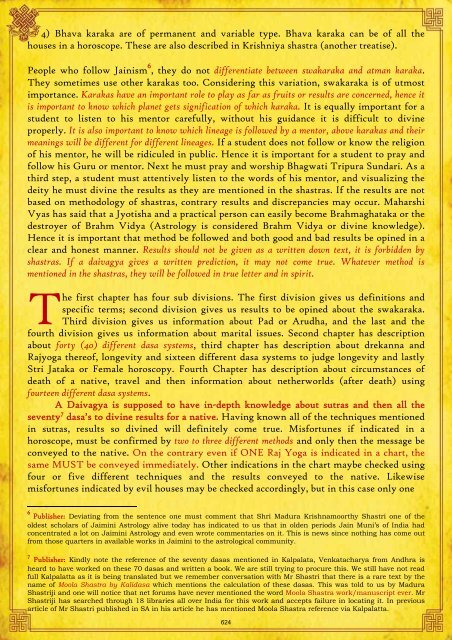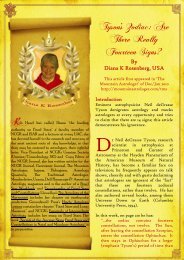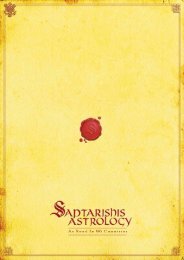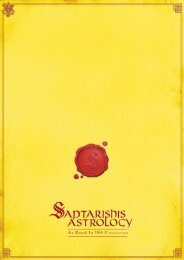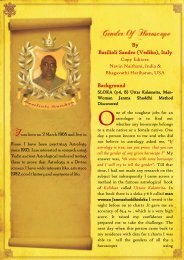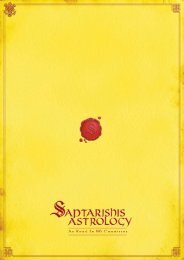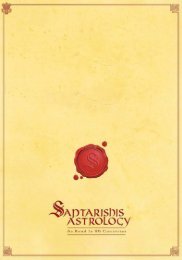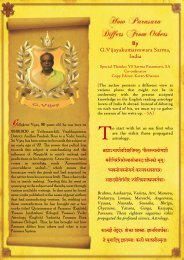4) Bhava karaka are of permanent and variable type. Bhava karaka can be of all thehouses in a horoscope. These are also described in Krishniya shastra (another treatise).People who follow Jainism 6 , they do not differentiate between swakaraka and atman karaka.They sometimes use other karakas too. Considering this variation, swakaraka is of utmostimportance. Karakas have an important role to play as far as fruits or results are concerned, hence itis important to know which planet gets signification of which karaka. It is equally important for astudent to listen to his mentor carefully, without his guidance it is difficult to divineproperly. It is also important to know which lineage is followed by a mentor, above karakas and theirmeanings will be different for different lineages. If a student does not follow or know the religionof his mentor, he will be ridiculed in public. Hence it is important for a student to pray andfollow his Guru or mentor. Next he must pray and worship Bhagwati Tripura Sundari. As athird step, a student must attentively listen to the words of his mentor, and visualizing thedeity he must divine the results as they are mentioned in the shastras. If the results are notbased on methodology of shastras, contrary results and discrepancies may occur. MaharshiVyas has said that a Jyotisha and a practical person can easily become Brahmaghataka or thedestroyer of Brahm Vidya (<strong>Astrology</strong> is considered Brahm Vidya or divine knowledge).Hence it is important that method be followed and both good and bad results be opined in aclear and honest manner. Results should not be given as a written down text, it is forbidden byshastras. If a daivagya gives a written prediction, it may not come true. Whatever method ismentioned in the shastras, they will be followed in true letter and in spirit.The first chapter has four sub divisions. The first division gives us definitions andspecific terms; second division gives us results to be opined about the swakaraka.Third division gives us information about Pad or Arudha, and the last and thefourth division gives us information about marital issues. Second chapter has descriptionabout forty (40) different dasa systems, third chapter has description about drekanna andRajyoga thereof, longevity and sixteen different dasa systems to judge longevity and lastlyStri Jataka or Female horoscopy. Fourth Chapter has description about circumstances ofdeath of a native, travel and then information about netherworlds (after death) usingfourteen different dasa systems.A Daivagya is supposed to have in-depth knowledge about sutras and then all theseventy 7 dasa’s to divine results for a native. Having known all of the techniques mentionedin sutras, results so divined will definitely come true. Misfortunes if indicated in ahoroscope, must be confirmed by two to three different methods and only then the message beconveyed to the native. On the contrary even if ONE Raj Yoga is indicated in a chart, thesame MUST be conveyed immediately. Other indications in the chart maybe checked usingfour or five different techniques and the results conveyed to the native. Likewisemisfortunes indicated by evil houses may be checked accordingly, but in this case only one6 Publisher: Deviating from the sentence one must comment that Shri Madura Krishnamoorthy Shastri one of theoldest scholars of Jaimini <strong>Astrology</strong> alive today has indicated to us that in olden periods Jain Muni’s of India hadconcentrated a lot on Jaimini <strong>Astrology</strong> and even wrote commentaries on it. This is news since nothing has come outfrom those quarters in available works in Jaimini to the astrological community.7 Publisher: Kindly note the reference of the seventy dasas mentioned in Kalpalata, Venkatacharya from Andhra isheard to have worked on these 70 dasas and written a book. We are still trying to procure this. We still have not readfull Kalpalatta as it is being translated but we remember conversation with Mr Shastri that there is a rare text by thename of Moola Shastra by Kalidasa which mentions the calculation of these dasas. This was told to us by MaduraShastriji and one will notice that net forums have never mentioned the word Moola Shastra work/manuscript ever. MrShastriji has searched through 18 libraries all over India for this work and accepts failure in locating it. In previousarticle of Mr Shastri published in SA in his article he has mentioned Moola Shastra reference via Kalpalatta.624
or two techniques are enough. If Raj Yoga is indicated in a horoscope, find the appropriatedasa when Raj Yoga will manifest, death maybe predicted during the last part of such a dasa. Ifindications indicate death within such a Dasa period, using two to three differenttechniques, death for the native may be conveyed for that particular period. It is the duty ofa Daivagya to test such techniques on sufficient horoscopes and gain proficiency in divingresults for a native. For natives born in or with Raj Yoga, results maybe conveyed to thenative in a pleasant manner.Phalit DasasNow Phalit Dasa systems are described.1) One finds mention about forty dasa systems in the second chapter, of these ONLY elevensuch dasa systems are indicated for natives born with Raj Yoga. A Daivagya must know thesedasa’s and techniques to convey results to a native.2) For natives born with extraordinary destines, only five dasa systems are indicated.3) There are several ordinary dasa’s, but for Raj Yoga only four dasa’s give results of RajYoga. These four dasa’s are Yogardha Dasa (Raj Yoga causing planets), Labhadipati’sDrekkana Dasa, Bhava Rahasya Dasa, Mandooka Pulit Dasa. For a native born with RajYoga, even if one dasa system indicates period where kingly status may be conferred onthe native, it must be conveyed appropriately.4) Ordinary dasa’s are Nakshatrabhed Dasa, Nakshatraja Dasa, Nisargdasa, Chardasa,Charparyaya Dasa, Sthirparyaya Dasa, and Gochar (transit planetary) Dasa. In theabsence of any good Yoga’s in a horoscope, these ordinary dasa’s maybe used to divineresults for a native.5) For longevity predictions all natives are covered by four dasa’s, mainly Brahma Dasa,Varnada Dasa, Chardasa and lastly Charparyaya Dasa. Other dasa’s can be usedwherever applicable.6) If Brahma amongst planets cannot be easily identified, taking the rasi of the native, aDaivagya may calculate imaginary Brahma and dasa’s maybe calculated to divine resultsfor the native.VarnadaVarnada Lagna maybe calculated in the following manner – Add or subtract (the words usedin original devnagri script are Milaker aur Vibhakta kerna) the longitudes of Hora lagna andAscendant (Udaya Lagna), find the weakest trikona from this spot and calculate dasaaccordingly. Hence four different Varnada Lagna’s and dasa’s maybe calculated. A Daivagyamust use his sense of judgment to find which of these four calculations agree with each otherand divine death for the native. Whenever death inflicting period is known, a Daivagya mayuse Kaksha Vriddhi and Kaksha Hrasa to adjust death inflicting dasa and then divine deathfor a native.In the chapter on Drekanna, several methods of longevity are described, but aDaivagya may use his skills to judge longevity to arrive at conclusions. He MUST then useGhatika Lagna and calculate Ghatika’s and then calculate dasa’s and divine death or travel towardsthe ending portion of such a dasa.625
- Page 2: Special Thanks(In Alphabetical Orde
- Page 5 and 6: 33 New Light On Jaimini Astrology-4
- Page 8 and 9: May The Sage Guide & ProtectChandra
- Page 10 and 11: Sv pÆIhIní píaÑ+at&smiNvt>,laix
- Page 12 and 13: Mangala, thus both their malfeasanc
- Page 14 and 15: mat&pu{yàÉaven v
- Page 16 and 17: æat&æa - - - - - - - sumTya
- Page 18 and 19: Being rich from childhood, he gets
- Page 20 and 21: If the 7th lord is not strong he is
- Page 22 and 23: He becomes a great king or someone
- Page 24 and 25: Brief Introduction:Krushiparashara
- Page 26 and 27: cÉiÉÑuÉåïSÉliÉaÉÉå ÌuÉ
- Page 28 and 29: the evolution of Kautilya’s Artha
- Page 30 and 31: Sage Parashara says that in the yea
- Page 32 and 33: Culled from Valmiki Ramayana, [2/54
- Page 34 and 35: Sage Parashara now invites attentio
- Page 36 and 37: ´ÉÏ aÉhÉåzÉÉrÉ lÉqÉÈKal
- Page 38 and 39: will be grateful. The reason this e
- Page 40 and 41: on this mortal plane is immortal. T
- Page 44 and 45: AspectsNow salient features of dris
- Page 46 and 47: irth.If Saturn and Rahu are both in
- Page 48 and 49: If this combination receives aspect
- Page 50 and 51: Kalpalatta(Devanigiri script)अथ
- Page 52 and 53: drekkaṇa śāstrasya antarṅgatv
- Page 54 and 55: tāstu yathāsaṁbhavavaṁ paryā
- Page 56 and 57: शाेषु अिधग ाक
- Page 58 and 59: चतुिवर्धाः म
- Page 60 and 61: Gauli PatanamByV.Raghavendra Rao, I
- Page 62 and 63: On leg fingersOn the head - at back
- Page 64 and 65: This is a translation of a Telugu P
- Page 66 and 67: 648
- Page 68 and 69: Tatkalin Bhrigu Prashna - Part 1ByB
- Page 70 and 71: Calculation & Example:1) Numeric va
- Page 72 and 73: Answers:1. The bad phase is over an
- Page 74 and 75: As the time is going medium phased
- Page 76 and 77: Analysis -10OH Seeker your work at
- Page 78 and 79: At this current phase there is a de
- Page 80 and 81: All your efforts at this moment see
- Page 82 and 83: 2. Do some worship and donations to
- Page 84 and 85: The enemies would be destroyed and
- Page 86 and 87: Analysis -30Oh Seeker the answer to
- Page 88 and 89: the subject.The translator at the i
- Page 90 and 91: िशरश जीविचंत
- Page 92 and 93:
translation of the verse differ fro
- Page 94 and 95:
Sage Bhrighu’s BlessingsBhrighu S
- Page 96 and 97:
died of pneumonia, his father’s a
- Page 98 and 99:
Divisional: D-4In D-4, Rahu is in t
- Page 100 and 101:
In the health divisional chart (D-6
- Page 102 and 103:
Kakshya: Rahu is in the Kakshya of
- Page 104 and 105:
4. 11° 15"to 15 °00" Sun5. 15 °0
- Page 106 and 107:
Chart No. 4 AbroadThe native is of
- Page 108 and 109:
A 2A10A 6 A5A 2A10A 6 A5Conclusion:
- Page 110 and 111:
Venus after examining the chart for
- Page 112 and 113:
DOB: 18-July-1968 POB: Amalapuram,
- Page 114 and 115:
DOB: 14-Dec-1964 POB: 04:35 a.m. PO
- Page 116 and 117:
Yoga there is a Yoga bhanga too for
- Page 118 and 119:
Chart 1:DOB: 29-Aug-1969 POB: Hyder
- Page 120 and 121:
DOB: 17-July-1964 POB: Kakinada TOB
- Page 122 and 123:
The lady of above chart once challe
- Page 124 and 125:
6. 18° 45 "to 22 ° 30 " Mercury7.
- Page 126 and 127:
during his 40 th year, as Jupiter
- Page 128 and 129:
Jupiter is in the kakshya of Moon t
- Page 130 and 131:
Sage Bhrighu’s BlessingsBhrighu S
- Page 132 and 133:
This is rather grim and we can see
- Page 134 and 135:
Saturn 9L of father aspects the 4H
- Page 136 and 137:
Saturn, placed in his Pisces Ascend
- Page 138 and 139:
Saturn is placed in the 7H of marri
- Page 140 and 141:
14 d) If for e.g. Asc is Virgo and
- Page 142 and 143:
Now use BSP 14 a) & b), check the l
- Page 144 and 145:
oy got major fractures in the hip r
- Page 146 and 147:
Let us take a chart which is not ea
- Page 148 and 149:
Sage Bhrighu’s BlessingsBhrighu S
- Page 150 and 151:
Venus the 8 th lord of chronic dise
- Page 152 and 153:
You can see that Venus is in the 12
- Page 154 and 155:
Use BSP-15 instantly and you can se
- Page 156 and 157:
the breasts then use BSP-15f and Ve
- Page 158 and 159:
their future cooperation, expressin
- Page 160 and 161:
ï†êˆFó Mì讬èc˜ŠðóE
- Page 162 and 163:
(6)ᘈîºè ï†êˆFó‹, Ü
- Page 164 and 165:
Aóè à¬îŠ¹ Üô ôŠˆ¬î A
- Page 166 and 167:
Mrigasira Swati Sravana PushyamiAri
- Page 168 and 169:
It is horse stable, for Poorvashada
- Page 170 and 171:
Natshetrayogam can be obtained by c
- Page 172 and 173:
want of proper information for appl
- Page 174 and 175:
4 P- Fourth Pada : Dhanush Rashi5 P
- Page 176 and 177:
Table 4: Pada Dasas Of PlanetsPlane
- Page 178 and 179:
Mer SatJup12PLPSatKet2P 8P9 P 3 P11


